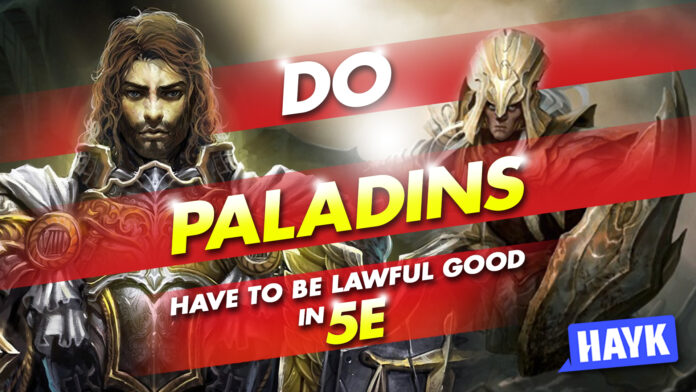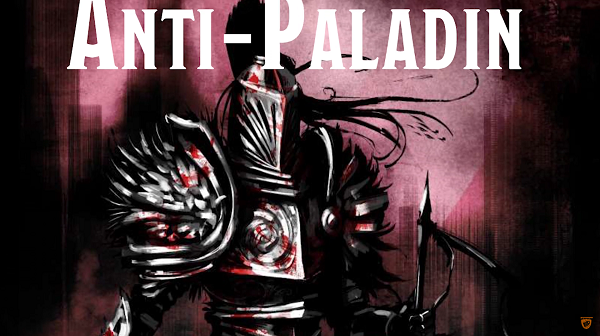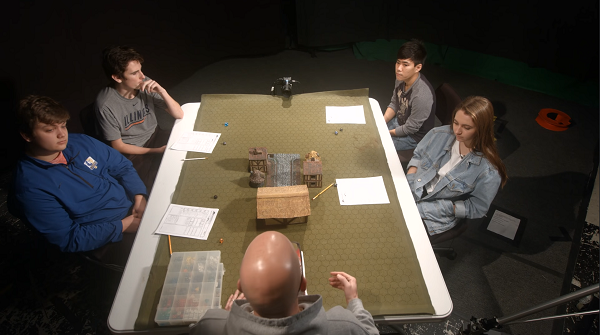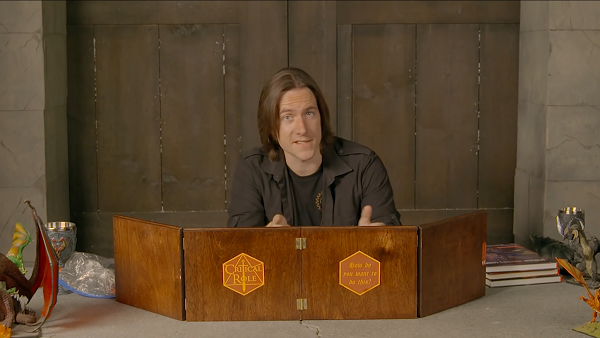
Lawful good Paladins are the cornerstone of an adventuring party. Through innate divine powers, a Paladin can become a reliable tank, holding down the frontline and supporting other characters. Now, what if the lawful good character Paladin changed into lawful evil (or chaotic evil)?
A D&D 5E evil Paladin can still be a strong tank but it is no longer a beacon of goodness. Rather, the evil Paladin or an Oathbreaker will utilize the forces of darkness to support his or her goals. This approach can be detrimental to the moral cohesion of the party.
But don’t worry – we’ll help you build an interesting D&D 5E evil Paladin that offers great room for character development. Plus, this article will also cover some popular multiclass builds focused on the Paladin.
Contents of this Page
How Would You Build A D&D 5E Evil Paladin?
You need to be careful about building an evil Paladin character. Even though 5E offers a great creative leeway in character-building, the system can still hinder your character’s growth without proper guidance.
Betraying The Paladin Sacred Oath
Becoming an evil Paladin shouldn’t be an instant affair. Your character should witness a strong event that breaks the bonds of the Paladin sacred oath. The oath-breaking effect is even more realistic if your character can nurture a deep font of anger while adventuring.
These are some guide questions that will help you shift towards an evil Paladin gameplay:
• What is your character’s motivation for being evil?
• What are your next goals after being an evil Paladin?
• Who are your character’s current enemies and allies? Be wary of spells maps monsters
• Which party member might be against your current path?
• Do you need a specific magic item for your evil journey?
• Do you plan to work with the BBEG or any of its minions? Why?
• What is your backup plan in case the new sacred oath Paladins fails in any way?
• Do you intend to multiclass? What class would you pick later?
• Do you need extra feats to make your character stronger?
You must have a strong reason and authority before taking the path of an evil Paladin. Always coordinate with your DM regarding your plan to break the Paladin’s oath. Some DMs might reject the idea of oath-breaking for the sake of campaign balance. As a player, you just have to understand the situation.
Justifying Evil Actions

An evil Paladin is often connected to evil actions. Most of these actions are related to deliberate destruction of groups, NPC torture, covert operations, and even racial pillaging. If you’re uncomfortable with these actions, then you shouldn’t take the path of an evil Paladin.
It’s important to find a way to justify a character’s evil actions. Fortunately, this is a rather easy thing to do in D&D. You just need to examine your backstory, goals, motivations, and gameplay expectations. If you’re unsure about an evil action, you should talk to your DM privately. The DM will tell you about your evil actions’ specific limitations and consequences in the campaign.
Anyone can use a limitation marker to indicate discomfort regarding an evil action during a session. The DM would take note of the marker and discuss possible alternatives that won’t affect everyone’s enjoyment of the game.
Be Wary of Consecrated Stuff: Is it Worth the Exchange?
Every DnD world contains areas and items empowered by many sources of magic. Divine magic, for example, is prevalent among holy areas, churches, and temples. Most characters won’t have problems entering consecrated areas, but evil Paladins might receive some penalties. The possible penalties are instant share report save checks against radiant damage, status effects, spell warding, and a pitched combat encounter.
Consecrated items are also problematic. If the magic item is rigged with divine power, it can greatly affect the evil Paladin’s abilities. Therefore, all evil Paladins should be extra careful while handling magic items or dealing with such exchanges – especially the ones found in temples or churches.
Likewise, desecrated items (tainted by fiendish magic) can affect good-aligned and neutral characters. These items can also affect evil Paladins to a variable degree.
Strategies for dealing with consecrated items:
• Always use Identify on a recently-found artifact, relic, or item
• If Identify is not possible, ask for Arcana or Investigation checks instead
• Urge or coerce an NPC to handle the magic item
• Use a custom identifying tool if possible
• Transport the item safely and contact a magic-user from the nearest town
• Let the toughest party member handle the item, but support him/her afterwards
• Prepare for counter-effects and possible adventuring changes
Don’t let greed overtake your rationale. Always bear in mind that DnD’s magic items are double-edged swords that can make or break your character. You won’t lose anything if you err on the side of caution.
Mind Your Friends

Even though being an evil Paladin is somehow driven by selfishness, it’s still not an excuse for you to ignore what other players feel. As a responsible player, you must inform your friends and party members about your intended path. If some people you are playing with feel that your chosen path is detrimental to the party, you can always try to negotiate. A good DM will offer some alternatives and compromises that everyone can work with.
When it comes to encounters, you should always put teamwork above other priorities. If you intend to betray your party members, tell them ahead of time or inform the DM. Remember, DnD is a collaborative storytelling game. Only the characters should be blind to intentions, and not the players.
Take note of the characters that might resist the implications of your new oath. These characters are mostly lawful good fighters, knowledge-driven wizards, and happy-go-lucky bards. If you know the backstories of your fellow party members, you can even reform your evil Paladin into a strong and dependable champion of darkness.
Notoriety Through Sub-Quests
An evil Paladin isn’t truly evil if he doesn’t have a level of notoriety. There are many ways to build notoriety, and all of them have a variable risk-to-reward ratio. Burning down an entire village, for example, is more heinous than stealing a minor divine relic. There might be a great reward for burning the village but at the cost of angering a powerful faction or group.
Instead of causing marginal disruption in a town, community, or society, you can just look for a side-quest during your character’s downtime. Side-quests can help you build notoriety without causing too much damage to the current town or village. Think of side-quests as part-time jobs that any character can take. Still, it’s all up to the DM if a specific Paladin holy quest or side-quest can affect a party’s reputation.
These are some side-quests that might fit an evil Paladin character:
• Covert temple desecration
• Stealing a holy relic
• Necromancer assistance
• Holy site desecration (i.e. A unicorn’s pond)
• Gathering of illegal materials
• Supporting a slow, nefarious plot
• Kidnapping of a cleric
If you think that your campaign doesn’t have a lot of sub-quests, talk to your DM. Let your DM know that sub-quests are important for character development and gaining additional XP along the way.
Coordinate With Your DM Properly

If you want to avoid most of the hassles and disadvantages of building an evil Paladin, you must coordinate with your DM regularly. Ask for advice regarding your character’s growth, other character ideas, or challenges. You should also assess if your planned evil actions can affect the party’s safety in the long run.
Whenever you’ve obtained a magic item from an unknown source, you must consult the DM as soon as possible. You won’t get direct clues about the item immediately, but you can learn some useful hints like the item’s elemental affinity or plot purposes. If you’re wary about a powerful magic item, you can avoid getting ensnared by a divine magic trap or powerful special oath spells or wards.
Choosing an Alignment: Notable Builds to Follow for A D&D 5E Evil Paladin
Sometimes, choosing a plain evil Paladin is bland and almost boring. You probably need a bit of additional flavor or some extra features that can define your new character.
You can save time by choosing any of our suggested builds. Our recommended builds range from following a straight alignment lawful good to pure evil. All of these builds have been tested, and they offer a neat balance of flavor and mechanical advantages.
Homebrewed Painbringer
Strength: Has the potential to inflict strong and crippling damage over time
Weakness: A bit squishy than the average good-aligned Paladin
The Paladin is a strong class backed up by useful abilities, spells, and game-changing oaths. Once a Paladin has reached high levels, its abilities would truly shine albeit on a more balanced scale. Now, an Oathbreaker or an evil Paladin can destroy the notion of balance and focus on inflicting tremendous pain after following homebrew sacred oaths.
If you want to maximize the full potential of a Paladin swallowed by darkness, you can take the path of a Homebrewed Painbringer. This character build relies on a high WIS score and continuous WIS prioritization. As much as possible, you need to find ways to further improve your WIS score while committing evil actions on the side. Also, the Homebrewed Painbringer relies on a lot of homebrew materials to gain immense power.
Since the Homebrewed Painbringer needs a lot of DM fiat, it thrives on clear communication. Talk to your DM about some possible magic items that rules races spells or something like races spells maps that can help fulfill your personal quest. Additionally, don’t forget about some mechanical feats that can augment your build.
The Dark Crusher
Strength: Tanky, but not as tanky as a Barbarian
Weakness: Above average class abilities
Anti-Paladins thrive on the evil force running through their veins. They are capable of unleashing harmful auras gifted by their dark deities. However, some Anti-Paladins or evil Paladins still prefer their weapons and raw physical strength over dark magic. If you’re keen on using melee classes equipment weapons while being evil, you should check out the Dark Crusher build.
The Dark Crusher benefits from a high STR score and an acceptable WIS score. Since the Crusher’s STR score is high, it can deliver huge points of melee damage per strike. Such a capability is essential in high-stakes combat encounters. It’s possible for a Dark Crusher to focus on melee attacks while switching to evil abilities now and then.
Even though a Dark Crusher can be a reliable tank, it will still have a hard time dealing with multiple foes. To make your Dark Crusher build more effective, you can take multiple sub-quests, downtime jobs, or character development opportunities. Focus on survivability because the DM will make harder encounters as time goes by. At around Level 15, you should have a strong balance of dark magic and brutal melee capabilities.
The Evil Faction Broker
Strength: Can broker beneficial deals with multiple factions
Weakness: It takes time to see the power of this build
If the Painbringer and Dark Crusher can be excellent soloists, the Evil Faction Broker is more effective in social encounters. The Faction Broker build combines the evil essence of the Paladin and the flexible social concepts of DnD 5E. It’s easy to build a Faction Broker Paladin but it’s also tricky to manage in the long run.
The Faction Broker build doesn’t require much in the beginning. You just need an acceptable CHA score complemented by WIS. After that, you must strengthen the build by seeking connections with the campaign’s prominent (or not so prominent) factions. Make sure that these factions are aligned with your goals to maximize the benefits that you can get. The benefits depend on your DM, your Paladin type (Oathbreaker or Anti-Paladin), and your general reputation.
When it comes to combat, the Faction Broker build is above average. The performance depends on many factors like your current level, equipment, spell list, and supporting party members.
The Evil Sumodin
Strength: Can summon undead, fell creatures, and even fiends
Weakness: Can be an easy target
The Sumodin is a shortcut for ‘Summoner Paladin.’ With this build, you can create a small undead or fiendish army. Also, you don’t have to wait too long before summoning your first creature. At Level 3, you can just take the Find Familiar spell and call an ally that will help you in battle. The type of familiar depends on your current oath. Some homebrew oaths will let you summon a fiend, while others are closely linked to undead.
There is no ability score restrictions or limitations with the Sumodin build. Just focus on making your STR, WIS, and CHA neatly balanced. Alternately, you can build the Sumodin with an above-average CON score.
One disadvantage of the Sumodin is the fact that it is an easy target. A summoner can boost a party’s action economy within three turns or less. This might compel the DM to target the Sumodin, especially if the enemy side has archers or spellcasters. So, just make sure that you’re teamed up with supportive party members or excellent artillerists.
The Paladinlock (Paladin-Warlock Multiclass)
Strength: Various thematic and mechanical bonuses especially with a Patron
Weakness: Noticeable compromises in terms of scaling damage and functionality
One of the coolest multiclass builds on DnD 5E is the Paladinlock. This build is a combination of the belief-driven Paladin and the patron-empowered Warlock. Crank the alignment to pure evil and you’d have a strong class combination powered by raw edginess.
Unless you have a thematic goal, you must dedicate higher levels to your Paladin class instead of Warlock. If you have decent Paladin levels, your smite damage and melee capabilities will scale accordingly. Warlock features like Pact of the Blade and Pact of the Tome can even make your evil Paladin build stronger.
Putting more levels in Warlock will make your build mechanically weaker but you’d get the chance to cast many cool spells. You can still nullify the weakness by choosing a strong oath focused on damage, status effects, and minion-summoning.
The Ferocious Smiter (Paladin-Artificer Armorer Multiclass)
Strength: Stronger Smite and cooler attack options
Weakness: Compromised Paladin features
Have you ever wanted to make your Paladin’s Smite cooler than what’s described in the rulebook? Instead of using Smite with a regular melee weapon, you can settle for a pair of arcane gauntlets that yields extra thunder damage. This unique way of smiting is possible through the Ferocious Smiter build or a Paladin-Artificer Armorer multiclass.
As long as you meet the proper multiclassing requirements, you can always rely on the Armorer’s uniquely functional armor and beneficial spells. If you intend to play an evil Paladin, your new arcane armor might appear spiky or filled with the skulls of your enemies. The Artificer’s infusions will even improve the effects of your arcane armor, increasing your character’s survivability.
By following this build, you must be prepared to let go of the Paladin’s other known features. You can invest two levels in Paladin to access the most useful features of the class such as Smite, Lay on Hands, and Spellcasting. Once your Paladin foundations have been set, you can now focus on building the Artificer side. Reversing the build is not effective because of the lack of synergy and utility scaling.
The Singer of Darkness (Paladin-Bard Multiclass)
Strength: Fun and interesting to play at lower levels
Weakness: Weaker at higher levels and college-dependent
Do you want to play an evil Paladin focused on singing dark hymns and melodies for a brutal deity? If you answered yes, then you must try the Singer of Darkness build or, simply put, a Paladin-Bard multiclass. This unique build can lead to interesting situations, but it is not meant for high-level play.
To start the build, you must take at least 6 levels on Paladin. While it’s still possible to take lower levels, a sixth-level Paladin has stronger foundations like an extra attack and the beneficial Aura of Protection. Plus, you also gain strong bonuses from your chosen oath. After setting the foundations, you can dedicate all of the succeeding levels to the Bard class.
Now, here’s the important part. You are required to pick a decent bard college to pursue, and most of them are fun to play. Some of the useful colleges are the College of Eloquence and the College of Lore. These colleges can boost combat performance and they will even improve Bardic Inspiration on higher levels. If it’s possible, do not pick an offence-focused college due to unimpressive damage scaling and lack of synergy. Or better yet, picking that offence-focused college on a later level will do.
The Devoted Evildoer (Paladin-Cleric Multiclass)
Strength: Remarkable survivability and strong class features
Weakness: Limited utility options for both classes
The Devoted Evildoer build (a.k.a. Paladin-Cleric multiclass) is all about maximizing opportunities and going all-out. Imagine: you’re an evil Paladin with a terrifying oath, and your chosen domain empowers that oath for a long time. While this Evildoer build relies on the synergy between a Paladin’s oath and the Cleric’s domain, it still has strong foundations right from the start.
The best domains that can function greatly with your chosen oath are Order and Forge. Thematically, these domains will match the edginess of your Paladin’s oath, and they also offer great options for combat. If you’ve chosen Forge Domain, your Paladin will become an exceptional tank with multiple weapon proficiencies. Order Domain, on the other hand, will turn your Paladin into an essential party supporter with many useful spells for any situation.
Just like in most multiclassing situations, you are required to let go of some of the chosen classes’ functional features. You just can’t have them all! For the Devoted Evildoer build, you can start by putting three levels on Paladin and investing the rest on Cleric. This path is already strong because the Paladin’s oath is already determined.
The Best D&D Accessories for An Evil Paladin Player
In order for you to feel the raw essence of the evil Paladin, you must obtain some items and accessories that can represent the character properly. You can use these accessories for your physical games, and they’re also excellent gifts.
Here are our top bets for evil Paladin accessories:
D&D Spellbook Cards for Paladin
As your D&D campaign goes on for many sessions, you will probably have a difficult time navigating through spells and abilities. You always need to refer to rulebooks, especially if you’re confused about a specific rule. Well, you can save time if your Paladin class share a box of D&D spellbook cards.
The D&D Paladin spellbook card box contains the commonly used Paladin spells. Aside from the regular spells, oath spells are also included in the box. Each spell card has a detailed text description and rule clarifications. The card art can also serve as a mnemonic to help you remember spell effects and exact rules.
You might notice some typo errors in the spell cards, but these are not too distracting at all. The box also feels tight the first time, making it harder for anyone to draw or return some cards. You can just use a separate box to solve this minor problem.
Silver Metal Dice Set for D&D
A silver metal dice set fits the personality of most Paladins: serious, tough, and definitely means business. If you want to make your rolls more significant and heavy, you should check out this dice set from Paladin Roleplaying.
The metal dice set comes with a professional box that has a strong vintage vibe. The box is durable and spacious enough to hold seven heavy gaming dice. Every metallic die looks easy to the eyes and has detailed numbers painted in black. You don’t need to squint or turn the dice a couple of times to see the numbers clearly. The metallic gaming dice are also heavy, so every roll will feel more authentic.
Some common problems with this silver dice set are dents and scratches in the box. These problems are mostly related to the shipping and product handling of the courier. Simply call the manufacturer if you think that the minor product damage is unbearable. Paladin Roleplaying’s silver metallic dice set is covered by a 1-year manufacturer warranty.
Forged Dice Co. Deluxe Dragon Storage Box for Dice
Do you know what’s better than a regular dice box? Well, an antique, dragon-themed dice box of course! Take a look at the antique-styled dice box from Forged Co. The box looks like an old treasure chest guarded by a ferocious dragon. Such a style is a great match to an evil Paladin’s personality. Think of the box as the personal hoard of the evil Paladin.
Inside the box is a removable foam bedding piece. You can use this bedding to ensure the safety of a special dice set. If you just want to store a clump of gaming dice, just remove the bedding and put everything in the box.
Be careful of transporting the box because its hinges are not strong. Put the box inside a separate carrying case if you’re planning to travel for a long time. The box also doesn’t have a lock, so the gaming dice might spill over accidentally.
FAQ About D&D 5E Evil Paladins
Are lawful good paladins stronger than lawful evil ones?
Answer: Not all the time. A lawful good Paladin’s strength comes from the divine magic imbued by the deity and the support of a specific community. Lawful good Paladins also make new friends easily regardless if they do lawful good restriction actions, allowing them to rally a big group whenever needed.
Lawful evil Paladins can also do the same, except that their path is more challenging because of numerous enemies who might stand in the way. Plus, evil folks tend to betray their allies often, so lawful evil Paladins must always be on guard.
Is it hard to roleplay an evil Paladin?
Answer: It depends on your experience with RPGs and roleplaying. An evil Paladin will often clash with the virtues of other characters. This emotional-psychological clash can lead to actual problems in the table. If you’re a beginner playing an evil Paladin, Anti-Paladin, or an Oathbreaker, you should seek the DM’s advice. By doing so, you can avoid most of the problems related to playing an evil Paladin.
What’s the difference between an Anti-Paladin and a Neutral Good Oathbreaker?
Answer: An Anti-Paladin doesn’t need to break an oath in the first place. Simply put, the Anti-Paladin is all about the acceptance of darkness and evil deeds. It’s also possible for an Anti-Paladin to follow the whims of an evil deity. An Oathbreaker, on the other hand, starts with a good, neutral good, or evil oath. He or she must break the oath to take the mantle of the Oathbreaker. And moving forward, every action of the Oathbreaker cannot be linked to the broken oath!
What are the challenges of having an evil Paladin in a party?
Answer: The most notable challenges are insubordination, strong convictions, utilitarianism, and stepping on the wrong toes. A party with an evil Paladin might have a hard time negotiating or forming relationships with NPCs. The party may even gain more enemies along the way, making encounters more difficult than ever. Some groups love the thrill of having an Anti-Hero around, while others prefer to be on the good side.
Can an evil Paladin desecrate or level an area?
Answer: A Paladin who broke his oath and followed an evil deity will have the magical power to desecrate anything. However, the speed of desecration depends on numerous factors like magical wards, holiness, and other characters involved. Likewise, a Holy Paladin can consecrate anything that’s filled with even a slight hint of darkness.
Should an evil Paladin have a high WIS score?
Answer: Technically, YES. A high WIS score will help the evil Paladin resist some spells and certain magical effects. Additionally, the Paladin’s WIS score will support its class abilities, features, spells, and saves.
Is an Oathbreaker Paladin considered an Anti-hero?
Answer: In a certain way, the Oathbreaker can be an Anti-Hero. One possible reason is the journey that the Oathbreaker must take. The Oathbreaker must adhere to his or her new oath and lead a life of utter conviction. This conviction might put the Oathbreaker at odds with most players and NPCs. If a player wishes to make an Anti-Hero Oathbreaker, he or she must follow the strict guidelines set by the DM.
Final Notes
Building evil Paladins are one of the exciting parts of your D&D journey. You must consider all possible aspects like backstory, motivations, and mechanical usefulness. On top of everything, you must talk to your DM about your character concept ideas and goals to ensure you play by the Dungeons and Dragons player handbook at all times.
Do you want to try out an evil Paladin character? Well, build your character now and tell us about your planned concept!





